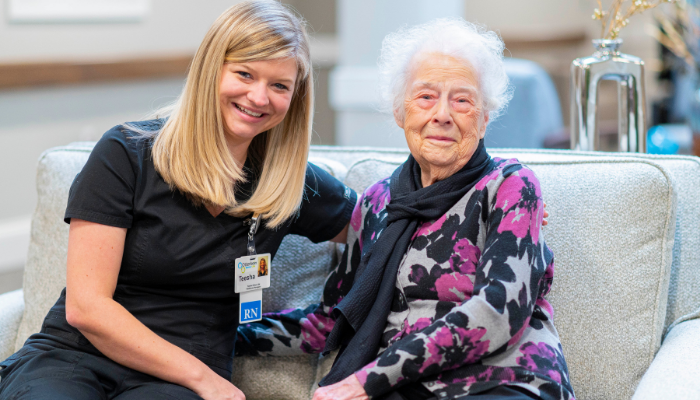Caregivers, this one is for you. Here are some helpful tips for avoiding caregiving-related injuries and emotional tolls.
Do back strains or muscle pulls from helping someone in and out of a chair, bed, or bathtub sound familiar? How about neglecting personal wellness because you lack free time? You don’t need to (care)give until it hurts any longer.
Those in your care need you to be in good physical and emotional health to provide for them adequately. Compromising your well-being won’t help you or your loved one. Below are five actionable steps to prevent injury and take care of yourself while caregiving.
Related: 4 Ways You Can Reduce the Stress of Caregiving >>
1. Learn and Implement Proper Lifting Techniques
Learning how to lift, turn, or transfer a senior correctly is an essential skill for all caregivers. With improper pulling and lifting, caregivers put themselves, and the individual they are tending to, at risk. Caregivers should be especially mindful when helping an older adult in and out of a wheelchair, bed, chair, or shower to prevent common caregiving injuries to the back, neck, and shoulders.
It may be wise for a caregiver to watch a professional lifting their loved one to learn the best lifting form. Notice that experts:
- Maintain stable feet with their weight distributed equally
- Avoid bending at the waist or twisting their backs
- Keep the other person close to their bodies when moving them
- Use their legs to lift
If the adult is too heavy for your abilities, getting additional help is necessary for everyone’s safety (see #5).
2. Make the Home Environment Safe and Smart
Did you know that one in four adults over the age of 65 experiences a fall each year? You can reduce in-home fall risks by eliminating household items that could prove hazardous.
Remove throw rugs, wheels on chairs, and door locks that would keep you from accessing someone who has fallen. Add hall railing, a raised toilet seat, non-slip treads on steps, and a shower chair or grab bar. Mobility tools such as pivot pads and gait belts can help you move your loved one safely. Keeping rooms well-lit and free of clutter improves visibility and allows everyone to move safely throughout the home.
3. Wear Proper Attire
Dressing for the caregiving job isn’t a matter of fashion—it’s a matter of necessity. Caregivers should thoughtfully evaluate the attire they wear when assisting someone in day-to-day tasks. Foremost, a caregiver will want to dress in functional and comfortable clothing that allows them to move without resistance.
When it comes to preventing injuries, shoes play a vital role. Wearing slip-resistant and flat-soled shoes will help you maintain traction on all surfaces, which is especially critical when moving someone.
4. Carve Out Time for Your Health
When caring for someone else is your main priority, you might tend to ignore personal care—and negative effects could follow. Caregiving is already demanding, and many caregivers lack time to address their own needs. If you find yourself with feelings of anger around caregiving, you may be overwhelmed.
Setting boundaries can be helpful. Assess the areas of your life that are getting too little attention, and shift your schedule to allow time for what you need and want. Sleep, exercise, meal preparation, and socializing are everyday activities that caregivers brush off. Scheduling time for caregiving and, likewise, for yourself, can help you become the best caregiver possible.
5. Find People to Help
Caregiving is a rigorous, injury-prone activity that can be difficult to take on alone. Remind yourself that you are doing the best you can and, if needed, turn to others for assistance. A helping hand is especially valuable when lifting or repositioning someone.
Identify and ask one or multiple family members or trusted friends to assist you. Schedule additional help for the most physically challenging caregiving tasks, such as bathing or transferring someone in and out of bed.
Additionally, joining a local or virtual support group can help you talk through the challenges you are experiencing while learning strategies for overcoming them. You may find it beneficial to participate in a group that targets your loved one’s medical or physical needs explicitly. Trying to go it alone can lead to caregiver burnout.
Respite Care and Adult Day Services at Otterbein
If you find caregiving too physically strenuous or emotionally stressful, Otterbein SeniorLife can help.
Our short-term respite care or adult day services could provide you with a much-needed break from your caregiving responsibilities. Your loved one will be safe and well cared for while you take some time to recharge (which every caregiver needs from time to time).
Discover More About Respite Care and Adult Day Services


